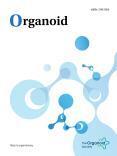
| Volume 4; 2024 | http://j-organoid.org |
 Notice Notice |
| 1. "Mini Symposium-Online" |
|
- Date: 2021. 03. 25 (Thr) - Topic: “Organoid culture and analysis” (Free registration) |
| 2. The 4th Annual Meeting |
| - Date: 2021. 10. 27-28 - Location: Convention center, Seoul National University Siheung Campus |
- Aims and Scope: http://j-organoid.org/about/
- E-Submission: http://submit.j-organoid.org
We are pleased to deliver table of contents alert
for Organoid
Open access articles are now available at http://j-organoid.org

Volume 4; 2024
| Original Articles | |
| ERdj5-mediated regulation of proliferation and differentiation in colon organoids under inflammatory stress | |
| Hyunjin Jeong, Jaewon Cho, Hyun-Jeong Ko | |
| DOI: https://doi.org/10.51335/organoid.2024.4.e3 | |
| Modelling Fabry disease with kidney organoids derived from human embryonic stem cells using CRISPR-Cas9 mediated gene editing | |
| Su Jeong Lee, Kyung Jin Lee, Joo Hyun Jee, Hyokyung Lee, Lina Joo, Woo Hee Choi, Jongman Yoo, Hye Yun Jeong | |
| DOI: https://doi.org/10.51335/organoid.2024.4.e2 | |
| Review Articles | |
| Mimicking microbone tissue by 3-dimensional printing | |
| Seung Yeon Lee, Jin Woo Lee | |
| DOI: https://doi.org/10.51335/organoid.2024.4.e4 | |
| Telencephalic organoids as model systems to study cortical development and diseases | |
| Woo Sub Yang, Ferdi Ridvan Kiral, In-Hyun Park | |
| DOI: https://doi.org/10.51335/organoid.2024.4.e1 | |
|
||